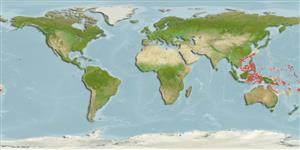>
Mulliformes (Goatfishes) >
Mullidae (Goatfishes)
Etymology: Upeneus: Greek, ypene, -es = upper lip (Ref. 45335); stenopsis: Name from the Greek word stenos, meaning 'narrow'; referring to the rather narrow (both in depth and width) caudal peduncle of the new species..
Environment: milieu / climate zone / depth range / distribution range
Ecologia
marinhas demersal; intervalo de profundidade 165 - 275 m (Ref. 92287). Tropical
Pacific Ocean: North to North-East Australia; Quezon, Philippines. The first record of a deep-water Upeneus goatfish for the Pacific.
Tamanho / Peso / Idade
Maturity: Lm ? range ? - ? cm
Max length : 13.1 cm SL macho/indeterminado; (Ref. 92287)
Descrição suscinta
Morfologia | Morfometria
Espinhos dorsais (total): 8; Raios dorsais (total): 9. This species is characterized by the following: Dorsal fins VIII + 9; pectoral fins 15-16; gill rakers 7-8+18-20 = 25-28; body depth at first dorsal-fin origin 22-25% SL; body depth at anus 18-21% SL; caudal-peduncle depth 7.4-7.8% SL; maximum head depth 22-23% SL; head depth through eye 18-19% SL; head length 33-34% SL; orbit length 9.2-9.9% SL; upper jaw length 14-15% SL; barbel length 21-22% SL; caudal-fin length 26-28% SL; anal-fin height 15-16% SL; pelvic-fin length 18-19% SL; pectoral-fin length 23-25% SL; first dorsal-fin height 20-23% SL; second dorsal-fin height 14-16% SL; total number of oblique caudal-fin bars 7-9, colour of bars changing from pale brown proximally to dark brown towards rear caudal-fin margin; dark bars on upper caudal-fin lobe 4-5 (including one bar close to rear end of lateral line), slightly increasing in width distally; lower caudal-fin lobe with 3-4 bars, of similar width as white interspaces between bars; first dorsal-fin tip black; caudal-fin bars and black dorsal-fin tip retained on preserved fish; barbels white; lateral body stripes absent; head and body silvery laterally and reddish dorsally, belly and ventral side of peduncle white; preserved fish dorsally or entirely pale brown or brown, with ventral part of body and head covered by white or silvery pigment (Ref. 92287).
Ciclo de vida ou comportamento de acasalamento
Maturidade | Reprodução | Desova | Ovos | Fecundidade | Larvas
Uiblein, F. and M. McGrouther, 2012. A new deep-water goatfish of the genus Upeneus (Mullidae) from northern Australia and the Philippines, with a taxonomic account of U. subvittatus and remarks on U. mascareinsis. Zootaxa 3550:61-70. (Ref. 92287)
Status na Lista Vermelha da UICN (Ref. 130435)
Ameaça para os humanos
Harmless
Uso pelos humanos
Mais informação
Nomes comunsSinônimosMetabolismoPredadoresEcotoxicologiaReproduçãoMaturidadeDesovaAgregação de desovaFecundidadeOvosDesenvolvimento dos ovos
Idade/TamanhoCrescimentoPeso-comprimentoComprimento-comprimentoFrequências de comprimentoMorfometriaMorfologiaLarvasDinâmica larvalRecrutamentoAbundânciaBRUVS
ReferênciasAquaculturaPerfil para aquaculturaEstirpesGenéticaElectrophoresesHereditariedadeDoençasProcessamentoNutrientsConversão de massa
ColaboradoresFotosStamps, Coins Misc.SonsCiguateraVelocidadeTipo de nataçãoÁrea branquialOtólitosCérebrosVisão
Ferramentas
Relatórios especiais
Baixar XML
Fontes da internet
Estimates based on models
Preferred temperature (Ref.
123201): 14.2 - 21.4, mean 15.3 °C (based on 33 cells).
Índice de diversidade filogenética (Ref.
82804): PD
50 = 0.5000 [Uniqueness, from 0.5 = low to 2.0 = high].
Bayesian length-weight: a=0.00955 (0.00454 - 0.02011), b=3.10 (2.93 - 3.27), in cm total length, based on LWR estimates for this Genus-body shape (Ref.
93245).
Nível Trófico (Ref.
69278): 3.5 ±0.4 se; based on size and trophs of closest relatives
Resiliência (Ref.
120179): Elevada, tempo mínimo de duplicação da população menor que 15 meses (Preliminary K or Fecundity.).
Fishing Vulnerability (Ref.
59153): Low vulnerability (10 of 100).
